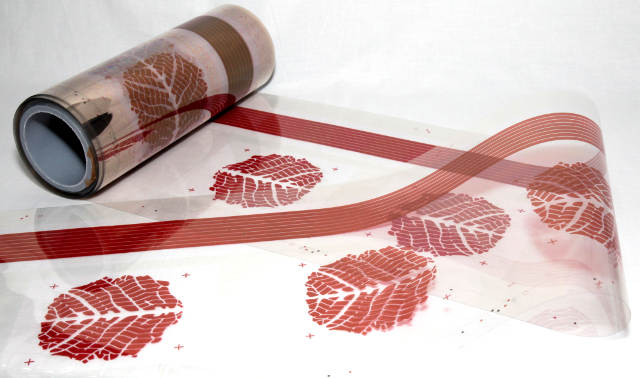Researchers at the VTT Technical Centre of Finland have developed a new mass production method for flexible organic solar panels, based on traditional printing technology.
The possibility of easily producing flexible solar panels offers a whole range of new design possibilities, with the solar panels offering aesthetic value for both the interior and exterior of buildings.
 Researchers at the VTT Technical Centre of Finland have developed a new mass production method for flexible organic solar panels, based on traditional printing technology. The possibility of easily producing flexible solar panels offers a whole range of new design possibilities, with the solar panels offering aesthetic value for both the interior and exterior of buildings.
Researchers at the VTT Technical Centre of Finland have developed a new mass production method for flexible organic solar panels, based on traditional printing technology. The possibility of easily producing flexible solar panels offers a whole range of new design possibilities, with the solar panels offering aesthetic value for both the interior and exterior of buildings.
Image credit: Antti Veijola
VTT’s innovative mass production method allows creation of various interior design elements using organic organic photovoltaics (OPV). These panels can harvest the energy from sunlight, and also wasted energy from interior lighting.
The efficiency of these organic solar panels is relatively low, but harvested energy is sufficient to power small sensors and devices to collect environmental information. The solar panels can be placed on advertisement billboards, machines, walls and windows, and can be made into a wide variety of shapes, in contrast to the simple rectangular shapes common to existing photovoltaic panels.
VTT's gravure and screen printing technologies enable production of solar panels with all their light-collecting and electrode layers contained in a sheet just 0.2 mm thick. In order to enhance its visual appearance, graphics can be printed onto these sheets.
Using materials available commercially, VTT has demonstrated the viability of this method using its own pilot manufacturing plant. VTT is now working with other partners to commercialize the technology.
Lower efficiency, lower cost
When compared to the commonly used silicon-based rigid solar panels, organic solar panels have a lower efficiency, although they are light and flexible. Printing machines that use the roll-to-roll method are used to produce the solar panels, making the process very easy to scale up to mass production.
The printing machine has the capability to produce 100m of the layered film every minute. OPV cells also require less material, and are recyclable, which helps keep their material costs down.
The organic photovoltaic cells market is under development and is expected to make a breakthrough within three years. The panel has a functional life of a couple of years which is sufficient for a wide range of applications.
Currently, VTT is analyzing the possibility of utilizing the roll-to-roll printing methods for producing inorganic solar panels using perovskite materials. Solution-based processes have been used for making perovskite solar cells in the laboratory, and these show considerable promise. When compared to organic photovoltaic cells, the perovskite solar cells are approximately five times better and their material costs are approximately ten times lower.
Decorative organic solar panels that are freely designed can harvest energy from indoor lights and hence can also be used for indoor applications. The panels can be manufactured at low-cost and after usage these materials can be recycled. Perovskite and other such new materials can be printed using the same methods.
Researchers at VTT are developing a method that would enable utilization of light in wireless data transfer, where the solar cells function as data receivers. This may lead to utilization of printable solar cells in new IoT (Internet of Things) related applications, where the devices would also have the capability of harvesting energy from the ambient light.